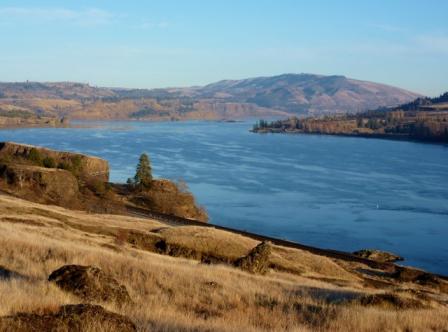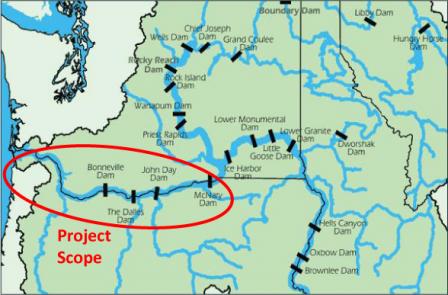EPA released its final Columbia River Cold Water Refuges Plan on January 7, 2021. See Documents below to read the full plan and supporting documents. Read EPA's press release.
Supporting Salmon Migration
About Cold Water Refuges
 Cold water refuges are areas that are colder than the main river temperature. Adult salmon and steelhead temporarily use cold water refuges to escape warm summer river temperatures and help them successfully migrate up the Columbia River to their spawning grounds. Protecting and restoring these cold water refuges is important for the survival of migrating salmon and the recovery of salmon populations.
Cold water refuges are areas that are colder than the main river temperature. Adult salmon and steelhead temporarily use cold water refuges to escape warm summer river temperatures and help them successfully migrate up the Columbia River to their spawning grounds. Protecting and restoring these cold water refuges is important for the survival of migrating salmon and the recovery of salmon populations.
 The Cold Water Refuges Project extends from the mouth of the Columbia River to its confluence with the Snake River (the Washington-Oregon border, at River Mile 310).
The Cold Water Refuges Project extends from the mouth of the Columbia River to its confluence with the Snake River (the Washington-Oregon border, at River Mile 310).About EPA's Plan
The Columbia River Cold Water Refuges Plan focuses on the lower 325 miles of the Columbia River from the Snake River to the ocean (see map). Cold water refuges serve an increasingly important role to some salmon and steelhead species as the Lower Columbia River has warmed over the past 50 years and will likely continue to warm in the future due to climate change.
The Columbia River Cold Water Refuges Plan is a scientific document with recommendations to protect and restore cold water refuges.
By issuing this plan, EPA is meeting its responsibilities under the Endangered Species Act associated with its approval of Oregon’s temperature standards for the Columbia River. This plan also serves as a reference for EPA’s Columbia and Snake Rivers Temperature Total Maximum Daily Load (TMDL).
The plan:
- Describes available cold water refuges (CWR) in the Lower Columbia River.
- Characterizes how salmon and steelhead use CWR.
- Assesses the amount of CWR needed to attain Oregon’s Clean Water Act CWR narrative water quality standard.
- Identifies actions to protect and restore CWR.
- Recommends future CWR studies.
Partners
EPA worked with Oregon, Washington, NOAA Fisheries, tribes, and other partners to develop the plan, including receiving valuable input from about twenty contributing parties on an October 2019 draft.
Contacts
- John Palmer (palmer.john@epa.gov), Project Lead, 206-553-6521.
- Andrea Lindsay (lindsay.andrea@epa.gov), Community Involvement Coordinator, 206-553-1896.
Documents
You may need a PDF reader to view some of the files on this page. See EPA’s About PDF page to learn more.- Columbia River Cold Water Refuges Plan (PDF)(216 pp, 18 MB, January 2021)
- Fact Sheet: EPA Releases Final Columbia River Cold Water Refuges Plan (PDF)(4 pp, 2 MB, January 2021)
- Appendix 1: Characterization of Columbia River Temperature Variability (PDF)(26 pp, 2 MB, March 24, 2020)
- Appendix 2: Evaluation of the Potential Cold Water Refugia Created by Tributaries Within the Lower/Middle Columbia River Based on NorWeST Temperature Model (PDF)(2 pp, 499 K, June 6, 2017)
- Appendix 3: Screening Approach to Identify the 23 Tributaries that Currently Provide CWR in the Lower Columbia River (PDF)(10 pp, 454 K, March 29, 2018)
- Appendix 4: Location of Upstream Extent of 23 CWR Areas Used by Migrating Salmon and Steelhead (PDF)(18 pp, 5 MB, November 11, 2018 (updated July 22, 2020))
- Appendix 5: Volume of Cold Water Refuge Associated with the 23 Tributaries Providing CWR in the Lower Columbia River and Selection of the 12 Primary CWR (PDF)(4 pp, 250 K, July 22, 2020)
- Appendix 6: CORMIX Modeling of Tributary Plumes in the Lower Columbia River (PDF)(22 pp, 3 MB, June 23, 2017)
- Appendix 7: Estimating the potential Cold Water Refugia volume within tributaries that discharge into the Columbia River (PDF)(2 pp, 232 K, June 9, 2020)
- Appendix 8: Estimates of Plume Volume Associated with Five Tributary/Columbia River Confluence Sites using U.S. EPA Field Data Collected in 2016 (PDF)(48 pp, 9 MB, March 1, 2017)
- Appendix 9: Estimated Cold Water Refuge Volume for the Wind River and Little White Salmon River/Drano Lake (PDF)(2 pp, 293 K, May 22, 2017)
- Appendix 10: Estimated Cold Water Refuge Volume in Herman Creek Cove (PDF)(3 pp, 597 K, June 1, 2017)
- Appendix 11: Supplement to Estimated Cold Water Refuge Volume in Herman Creek Cove (PDF)(14 pp, 3 MB, September 27, 2017)
- Appendix 12: Tributary and Columbia River Measured Temperature Data Summary (PDF)(42 pp, 10 MB, February 17, 2017)
- Appendix 13: Estimating the Number of Steelhead and Fall Chinook using CWR in the Bonneville Reservoir Reach (PDF)(38 pp, 3 MB, July 23, 2020)
- Appendix 14: Water Temperature Estimates of the Columbia River and Tributaries in 2040 and 2080 (PDF)(5 pp, 5 MB, March 13, 2019)
- Appendix 15: Stream Temperature Predictions Under Varying Shade and Climate Scenarios in the Columbia River Basin (PDF)(31 pp, 3 MB, November 20, 2018)
- Appendix 16: Assessment and Synthesis of the Literature on Climate Change Impacts on Temperatures of the Columbia and Snake Rivers (PDF)(34 pp, 11 MB, March 2020)
- Appendix 17: Water Temperature Estimates of the Lower/Middle Columbia River and Tributaries in 2040 and 2080 Based on the NorWeST Model (PDF)(4 pp, 990 K, June 7, 2017)
- Appendix 18: Predicted Maximum Temperature Using the NorWeST Model in 12 Primary Cold Water Tributaries and 2 “Restore” Tributaries (PDF)(1 pg, 82 K, April 11, 2019)
- Appendix 19: Comparison of NorWeST Future Temperature Estimates to a Continuation of Historical Warming Trends in the Lower Columbia River (PDF)(1 pg, 83 K, June 5, 2019)
- Appendix 20: Protect and Restore Snapshot Assumptions and Approaches (PDF)(11 pp, 592 K, August 6, 2020)
- Appendix 21: HexSim Migration Corridor Simulation Model Results (PDF)(86 pp, 3 MB, August 16, 2020)
- Appendix 22: Evaluation of Tributary Temperature Values Included in Table 2-3 of the CWR Plan (PDF)(27 pp, 4 MB, May 18, 2020)
- Appendix 23: Comparison Between NHDPlus Modeled August Mean Flow Conditions and Available Flow Data Collected at the Primary CWR Streams (PDF)(12 pp, 932 K, May 19, 2020)
-
Response to Comments on Draft Columbia River Cold Water Refuges Plan (PDF)(291 pp, 14 MB,
December 16, 2020)
EPA's responses to comments received on the October 2019 draft plan.
